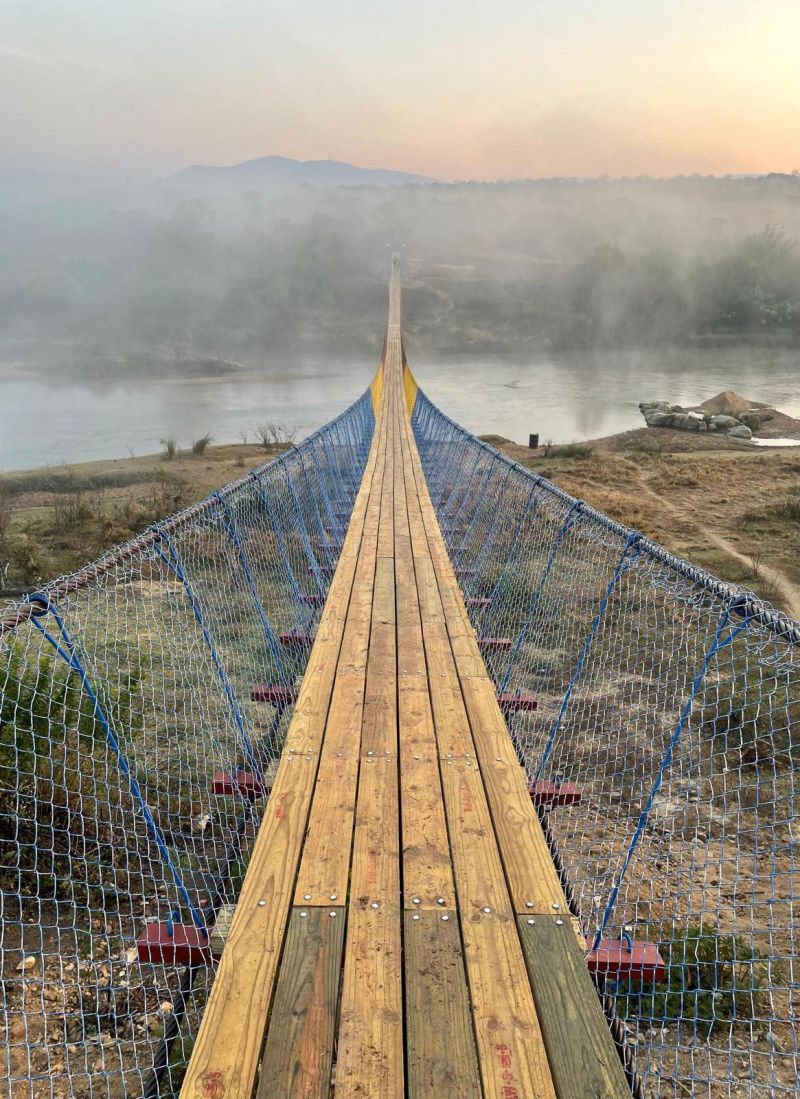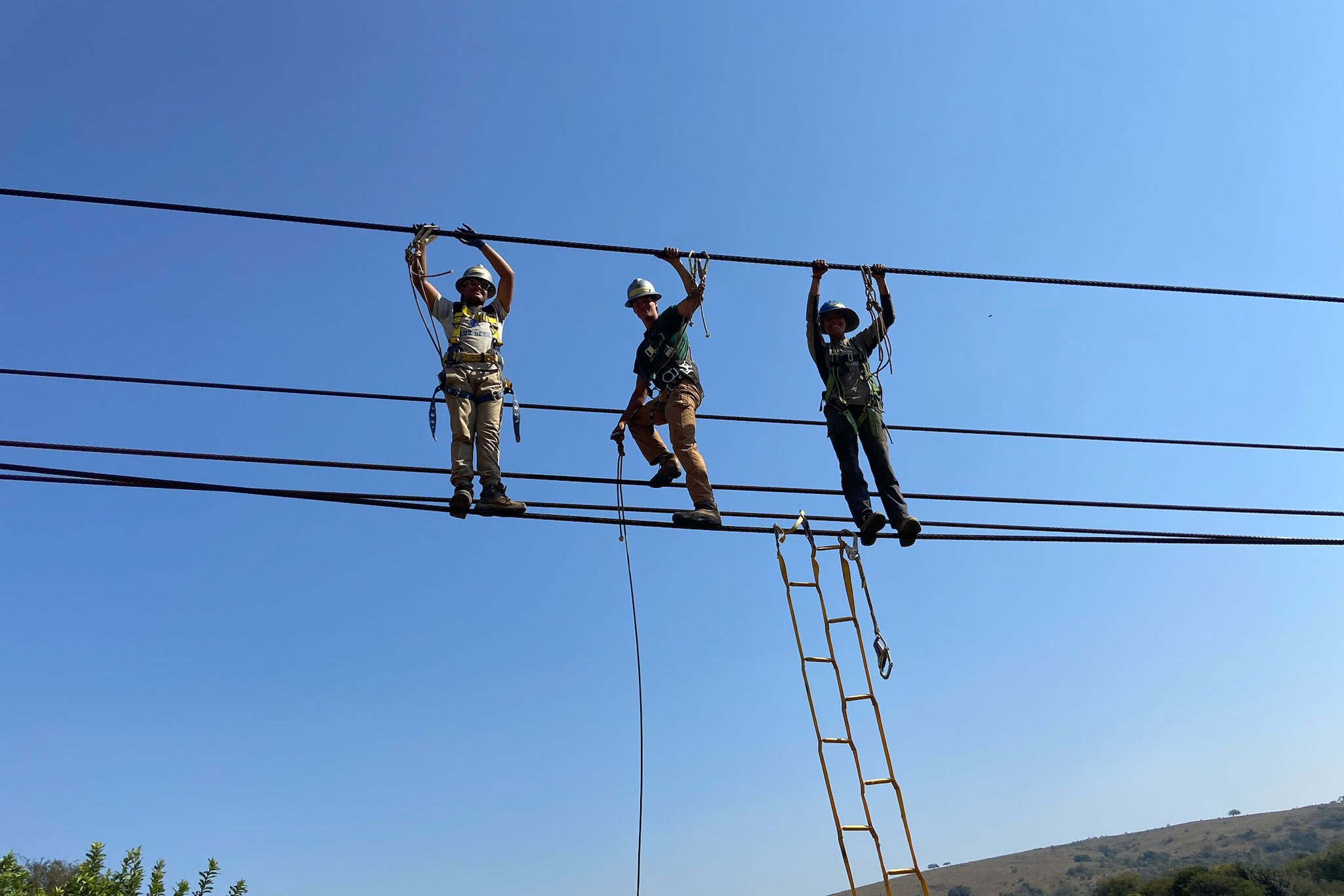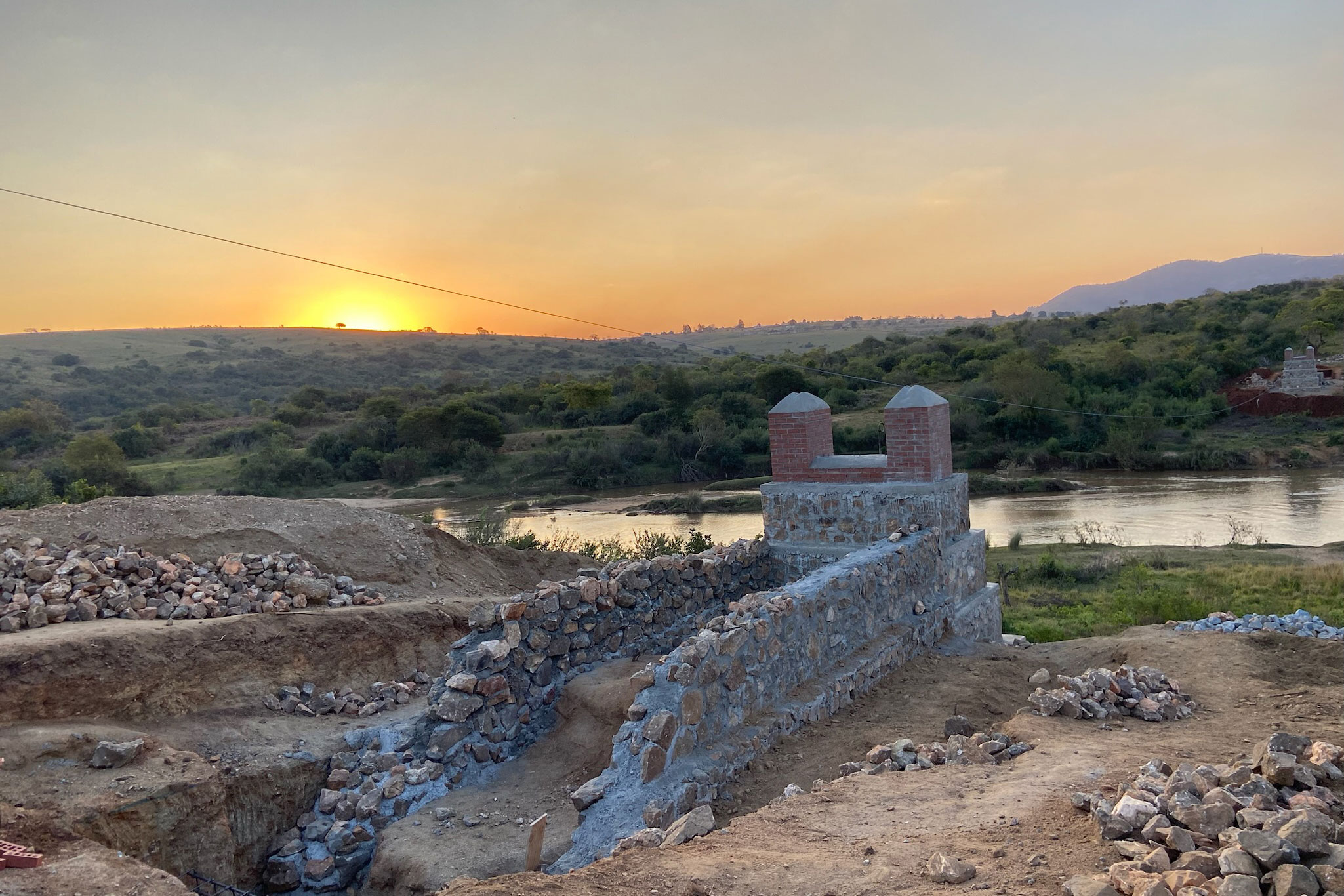Author: Sarah Rogers, Kenan Institute for Ethics
A DukeEngage project builds bridges with communities in Eswatini
EIA reached out to David Schaad, professor of the practice in civil and environmental engineering at Duke. He was a longtime EIA collaborator: he and engineering students in the Duke Engineers for International Development club first built a bridge with EIA in Bolivia nearly 15 years ago.
Schaad then submitted a proposal to DukeEngage, a program that sends students over the world for immersive summers working with communities to solve pressing issues. Schaad has directed programs for DukeEngage in Bolivia, Uganda, Indonesia and elsewhere.
And that’s how a group of 12 Duke students came to Eswatini to help build a 122-meter-long pedestrian footbridge over the Ngwempisi river.
Designing at Duke
Before the students even arrived on site, many of them had already put hundreds of hours of work into the project through Schaad’s Spring 2023 course, “Engineering Sustainable Design and the Global Community,” and the extracurricular club Duke Engineers for International Development (DEID, pronounced “deed”).
“This was the entirety of my spring semester,” said Hallock, both a student in the class and member of DEID. “I’d wake up, put a few hours into the project, go to class, then come back to my room at night and work on the project some more.”
“Emily worked insanely hard on it,” said Anya Dias-Hawkins P’25, also a member of the class and DEID, who served as co-project manager. “There were a lot of late-night calls and ‘Oh quick, we gotta get this and push it through.’”
The previous summer, Hallock and Dias-Hawkins had traveled to Bolivia to build a suspended bridge with EIA, so they had some sense of what was involved in such a project. But when they received the site information for the Eswatini project in November — including the length of the proposed bridge at 122 meters long — “We were like ‘whoa, this is gonna be crazy,’” said Dias-Hawkins.
 Though built with rudimentary materials, this bridge bears the imprint of a hundred minds and hands. Its fencing is painted in the national colors of Eswatini: red, yellow, and blue. Photo by Kyle Abrahm.
Though built with rudimentary materials, this bridge bears the imprint of a hundred minds and hands. Its fencing is painted in the national colors of Eswatini: red, yellow, and blue. Photo by Kyle Abrahm.
In addition to design presentations in the class, every stage of the students’ planning involved review calls with EIA and professional engineering mentors from its Bridge Corps, from preliminary designs to finalized designs and proposed bills of quantities.
“During the design stages, they’d look at it, give feedback, and we’d rework it and send it back,” said Hallock. “It’s thoroughly reviewed by professional engineers, but the program allows for significant autonomy for students in the design role.”
After they were approved for construction, the students’ final report detailed safety protocols, logistics, and other information, like where they would be staying. It was over 50 pages long.
On the Ground in Eswatini
They departed for Eswatini shortly after the spring semester ended. “Get back home, pack your bags, and then you’re off to Eswatini,” Dias-Hawkins joked.
The cohort of DukeEngage Eswatini students included several who worked on the project through Schaad’s engineering course and DEID. “We had such substantial investment in the project before we ever set foot in the airport,” said Hallock.
“We got a lot of people really excited to be part of this,” said Dias-Hawkins.
How do you build a bridge from the ground up?
Trick question. You build it from under the ground up.
“It can take a really long time to dig,” said Hallock. “This is the longest suspended bridge that [EIA] has done in any of the countries they’re operated in. This is also in a floodplain region. So there are massive abutments, massive holes that need to be dug.”
When the students arrived in Eswatini, the community members had already excavated a large portion of the foundation.
“Some people in the community spent decades working in the mines in South Africa,” said Hallock. “Almost everyone is used to doing manual labor. They are extremely competent.”
“They were so strong,” said Kyle Abrahm P’25, who served as one of the project’s construction managers. “And their mental strength as well, it was incredible.”
The community’s collective commitment to the bridge project was tangible. Some walked over two hours to get to the site every day.
“We had 20 to 40 community members on site every day,” said Hallock. “There were people on site who I don’t think missed a single day of work. A good portion of them were well over the age of 60. Some of those 72-year-olds were the hardest workers.”
“What DukeEngage is intended to do, and has done so well over the last 20 years, is give students a vision for the world around them in ways that are really impactful and tangible and humbling.”
David Schaad
Community members made all kinds of contributions to the building process. A group of women cooked and provided a huge midday meal to the students and workers onsite. The chairwoman of the community’s bridge committee raised funds to pay for gasoline and organized trucks to move materials. A man named Thokozane Nhleko, who served as the tool storekeeper, quickly became close to the students. They began every workday by checking in with him at the tool shed.
Excavation continued for two weeks after the students’ arrival. Then they built the ramp walls, stone by stone, until they stood 15 feet off the ground and six feet underneath it. A group of masons from Eswatini hired by EIA led this work.
“They’re essentially the foremen of this project.” said Harsh Mather P’26, who joined the project through DukeEngage and served as a quality control monitor.
Mather described how the head mason, Mangisi Sifundza, once invited the students to his home village, where they discovered that he was responsible for building most of it. “The masons know everything,” he said.
After the walls, they built the bridge’s towers. Then the anchor.
“The anchor is one of the biggest days of work,” said Hallock. “The whole bridge is held by this concrete anchor. It took 60 bags of cement.” In the end, the anchor weighed nearly 17 tons.
Each bag of cement weighed 110 pounds and had to be transported to site. It wasn’t so bad when they were working on the near side of the river, because they were able to use trucks and wheelbarrows, but they also had to cross the river to work on the other side.
“We have three guys on our team who can put it on their shoulder and carry it across,” said Hallock. “A lot of the time, we’re exhausted before the workday even starts.”
There were some unexpected hurdles during construction, such as when one of the cables fell off the delivery truck on its way to the site. The cable normally required a forklift to move. It weighed nearly a ton.
“Fifteen of us helped lift it,” said Hallock. “We somehow got it back into the truck.”
“I learned so quickly that no matter what plan you make for construction, it’s going to go wrong,” said Abrahm. “You just have to, on the fly, get people together, source a truck, drive out, and figure it out.”
Once they had all the cables on site, they hoisted them — another “big day” of work. “You secure the cable into the anchor by clamping it,” Hallock said, “and then you run it over the top of the tower, walk it across the river, pull it as hard as you can by hand and then clamp it in place.”
Walking the cables across the river required everyone on site. “This was the first time in the project all of us were working side by side,” Abrahm said. “We carried the cable through the river on our shoulders and then up and over the towers.”
 Students lead a safety presentation after the bridge cables were hoisted. Harnesses prevent the workers from falling to the ground, but if they lose their footing on the cables, they still need help getting back up. The students demonstrate how to come to their aid by using the ladder at the bottom of the photo. From left to right: Namaye Garodia, Palo Silva, and Maya Reeves. Photo by Nikhil Arayath.
Students lead a safety presentation after the bridge cables were hoisted. Harnesses prevent the workers from falling to the ground, but if they lose their footing on the cables, they still need help getting back up. The students demonstrate how to come to their aid by using the ladder at the bottom of the photo. From left to right: Namaye Garodia, Palo Silva, and Maya Reeves. Photo by Nikhil Arayath.
They hoisted the cables high into the air with a winch, and then dropped them down to let them settle —“setting sag.”
Then they continued to fill the abutments with stone. “We form rock chains,” said Hallock. “We pass the rock from person to person to person and then throw it in.”
Next was decking the bridge – laying down the planks that people would eventually walk across – then fencing both sides.
Safety was paramount throughout the entire process, especially “because you’re operating with limited machinery,” said Hallock. “Most of this has been done with shovels and pickaxes and an auto level.”
Professional engineers, the students’ mentors from Bridge Corps, visited the site regularly to sign off on critical construction stages.
As the bridge neared completion, the students’ anticipation grew.
“I’ll be able to walk across the first thing I ever designed,” said Hallock, sounding awed. “This project is so near and dear to my heart, and it motivates me every day I go to work.”
“We’re all like, ‘we’re super close to the end,’” said Dias-Hawkins.
After nine weeks, that end came.
“Everything was up and ready by Tuesday and Wednesday,” said Mathur, “and we were doing these finishing touches on Thursday. [The head mason] Sifundza and all were laying the last brick, and somewhere in the middle he goes, ‘I’ll miss you, Ndumane.’” (This was a nickname Sifundza gave him, a shortened version of the title “Interior Mason.”) “Then I realized, this is done!” The bridge stood, swooping over the Ngwempisi river, spanning a seemingly impossible distance from anchor to anchor. It even had a name: “Nyawoluhle.”
On Friday, the students, masons, and community members held a ceremony to celebrate. There was music, dancing, and lots of speeches, and then they all crossed the bridge together.
It was a bittersweet day. The students had to leave the homestead right after the celebration.
“Going into the inauguration knowing it would be our last day on site made it so hard to balance the mix of emotions,” said Dias-Hawkins. “It was an absolutely amazing experience, but such a hard goodbye.”
On the last day, Thokozane Nhleko, the tool storekeeper, told her that he was so happy and so sad at the same time. “In that moment, we both just stared at each other teary-eyed,” she said.
“We did build a bridge,” said Mathur, “but now that I look back, I just remember these connections we made.”
What We Gain From Working with Communities
“What DukeEngage is intended to do,” said David Schaad, “and has done so well over the last 20 years, is give students a vision for the world around them in ways that are really impactful and tangible and humbling.”
Teaching engineering students to work in international development, he says, means helping them develop a sense of perspective while working with communities in different countries.
“It’s not enough just to design this stuff,” he said. “We need to understand the cultural implications, the ethical implications, the policy impacts, the gender and social issues. We want to be really sensitive to how we enter into these situations.”
He rejects the assumption that these communities “need” the students. “They are harder workers. They can build stuff a lot better than we can. They are going to be owning it long after we’re gone. This is not something we’re giving to them…we’re doing this with them, and in many ways, we are the direct beneficiaries in ways that that we will never quite understand.”
Dias-Hawkins has now worked on two bridge projects — one as a cultural relations manager in Bolivia, and one as a co-project manager in Eswatini. She said they have helped her decide on a future career path: she wants to focus on disaster relief. “Getting into communities, seeing an issue, and understanding how to deal with it is what this project has given me,” she said.
Hallock emphasized how valuable it was to work on a project where a community’s needs aligned with her personal goals.
“I could not be more grateful for this opportunity,” she said. “It will have a significant impact on the people here, but the fact that they entrusted the design to me, and I’m able to use this as the pilot of my engineering career…it’s something that I’m forever grateful for.”
“It was a once-in-a-lifetime experience,” Abrahm said.


